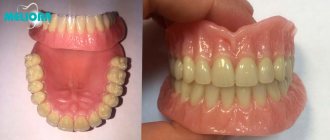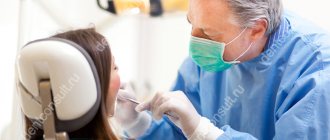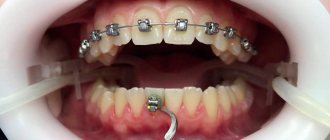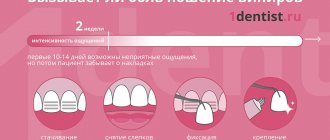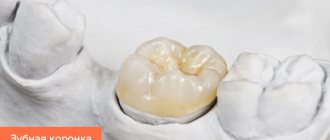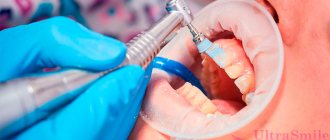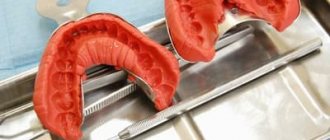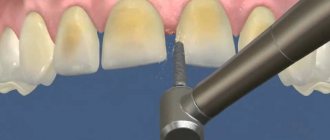A crown is the name in dentistry for a prosthesis that is placed on a tooth, on an implanted implant, or included in the structure of a dental bridge. With the help of dental crowns, you can restore severely damaged or lost teeth, the restoration of which must be carried out urgently and for this you must contact a dentist.
How the crown will be installed, whether it hurts to put a crown on a tooth - we will answer all these questions in detail in our article.
When is it necessary to put a crown on a tooth: indications for restoring teeth with a crown
The need to place a crown on a tooth may arise in the following situations:
- The tooth is severely damaged by caries. If the natural crown of a tooth is damaged by more than 50% by caries, then it would be more correct to put a crown on the tooth rather than restore it with a filling. Large fillings do not withstand the chewing load well and may fall out or break, and the tooth may break along with the filling. If the root of the tooth is damaged, then it will have to be removed. By placing a crown on a decayed tooth, you have the opportunity to save it;
- The tooth is destroyed as a result of trauma. If the roots of a tooth were not affected by injury, it is possible to restore the tooth - it will be enough to put a crown on it;
- You can also put a crown on a tooth for aesthetic restoration: for example, if a tooth is chipped or its enamel has changed color, becoming gray or yellow, and this defect cannot be eliminated by classic whitening.
Doctors recommend placing temporary crowns to preserve teeth for patients with periodontitis. In this case, crowns prevent teeth from becoming loose and falling out.
In your case, do you need to put a crown on your tooth or is it possible to use another restoration method? The doctors of our dental clinic in Moscow, “Firadent,” can help you find the answer to this question. To make an appointment with our specialists, you just need to dial our dental clinic’s phone number!
I need to put a crown on a tooth: is the treatment painful?
Statistics show that most people, knowing that they need to put a crown on a tooth, still postpone their treatment for fear of visiting the dentist and the pain that supposedly cannot be avoided with dental prosthetics. Does it really hurt to put a crown on a tooth? Let's look at this issue together.
So is it painful to put a crown on a tooth or not? The most painful stage in the process of installing a crown on a tooth will be the preparation, during which the teeth are treated for caries, depulped (if necessary), and also ground down to the thickness of the future crown. All these procedures are not performed without anesthesia, as they can cause quite severe pain to the person.
Before you begin to treat and prepare the tooth for placing a crown on it, the doctor will definitely perform an anesthesia procedure using a local anesthetic. The type and amount of the drug are selected individually for each patient. The use of anesthesia makes the process of preparing the tooth for crown installation painless.
If the patient experiences a literally panicky fear of dentists, in our dental clinic “Firadent” he may be offered dental treatment in his sleep[/anchor], under sedation. Sedation should not be confused with general anesthesia; it is a light medicated sleep in which the patient will remain during treatment. Sedation allows you to relieve the patient not only from pain when preparing teeth for prosthetics, but also from psychological discomfort and stress! Moreover, after sedation there are no negative side effects, which are not uncommon after general anesthesia.
You can read all the details on dental treatment during sleep in a separate article on our website, which is devoted to sedation, or find out during a consultation with the doctors of our clinic - “Firadent”.
A systematic approach to the manufacture of complete removable dentures
It has historically happened in dentistry that doctors almost never associate complete removable dentures with a high level of aesthetics, and place them at the diametrically opposite end of the pyramid of needs when treating patients with complete edentia compared to other designs. But today, the use of implants has made it possible to combine these two aspects into a single coordinate system. Complete dentures supported by dental implants are a fairly effective treatment option for patients with complete or partial edentia, providing a fairly predictable and successful rehabilitation option. But as Dr. Walter “Jack” Turbifil, DDS, once concluded, “the use of implants will never relieve the dentist of the need to ensure that the prosthesis meets all physiological and mechanical criteria.”
Rehabilitation of a completely edentulous patient poses many challenges. The position of the teeth, aesthetic parameters, phonetic function, occlusal plane, vertical component of the bite and the position of the condyles of the joint are determined according to canonical orthopedic principles. But most of these principles, unfortunately, are leveled out in a state of complete edentia. Even if a patient has been using a certain prosthesis design for some time, it should not be regarded as some kind of referent determinant, since old prostheses are very rarely associated with what the patient actually wants. In addition, during the treatment of patients with complete edentia, the dentist faces psychological problems associated with the patient’s loss of teeth, the development of xerostomia and neuromuscular disorders. This is also one of the reasons why dentists often shy away from treating patients with complete absence of teeth.
The step-by-step analog protocol for the fabrication of complete denture structures has remained virtually unchanged since its invention. Based on the existing impressions, models are cast, on which the technician models the wax base and bite ridges - that’s all. At this stage, proper communication between the dentist and the dental technician is extremely important to correctly determine the proper position of the anterior teeth, transmit data about the vertical component of the bite and the position of the joint. Even if digital technologies are used in the work, the clinician must be able to assess the patient's phonetic function, check aesthetic parameters and correct potential violations in the design of the prosthesis. When using complete denture structures as temporary or permanent restorations, or even as diagnostic structures, the protocol for their production requires a certain level of systematicity in its implementation. The latter should include:
- Registration of the position of the incisal edge of the teeth of the upper jaw
- Registration of the position of the incisal edge of the lower jaw teeth
- Determining the proper vertical bite
- Registration of the central ratio
- Proper installation of plaster models into the articulator
- Phonetic function check
Registration of the position of the incisal edge of the teeth of the upper jaw
The starting point for the manufacture of a complete removable denture is the determination of the vertical and horizontal position of the maxillary anterior teeth. This is achieved by using a sheet of base wax and a wax roller (photo 1).
Photo 1: Maxillary wax ridge with midline and high smile line markings.
The wax bead is contoured and reshaped to conform to surrounding structures, including:
- Horizontal and vertical position of the incisal edge of the teeth of the upper jaw
- Midline of the upper jaw
- Buccal corridors
- Occlusal plane of the maxilla
- High smile line
To check the correct position, you can fix them in a wax base (photo 2). To confirm the correct position of the teeth, the doctor must check the patient’s pronunciation of the sounds “F” and “V”: in this case, the patient must touch the line of transition of the wet part of the lower lip with the dry part with his front upper teeth. To record this position, the doctor may ask the patient to count to 50 or 60 out loud. For diagnostic purposes, the doctor can also obtain photographs of the position of the wax base and teeth at rest, with a high smile, and also in profile. Additionally, you can record several videos of the patient during a conversation, after which all this data can be transferred to the dental technician.
Photo 2. View of the wax roll with teeth 8 and 9 installed.
Registration of the position of the incisal edge of the lower jaw teeth
After determining the proper position of the incisal edge of the maxillary teeth, it is necessary to record the position of the incisal edge of the mandibular teeth. To do this, use a base wax plate and a wax roller (photo 3). The height of the wax ridge in the anterior part of the lower jaw should be 18 mm from the level of the vestibule to the predicted position of the cutting edge of the incisors. In order to eliminate restrictions on the articulation of the lower jaw, the distal parts of the wax roller are made below the occlusal plane, after which cuts are formed on the roller for connection with the wax roller of the upper jaw. In fact, the use of special wax in the projection of the anterior teeth of the lower jaw is the starting point of the next stage - determining the vertical component of the bite.
Photo 3. Using a special portion of yellow wax to test phonetic function with a height of 18 mm from the vestibule of the oral cavity.
Determination of the vertical component of the bite
According to the Academy of Prosthetic Dentistry Glossary of Prosthetic Terms, vertical occlusion is defined as “the distance between two selected anatomical or other marked points (usually one on the tip of the nose and the other on the chin) at maximum fissure-tubercle contact. The classic studies of Dr. Earle Pound demonstrate that the most accurate parameter determining the vertical component of the occlusion is “the height comfortable for normal phonetic function,” since it allows the most open and closed range of tooth relationships during jaw movements to be established, and does not depend on the level achieved bone atrophy or patient age. Recording the bite height that is comfortable for proper phonetic function is done when the patient produces the “C” sound, since the anterior teeth can then be used as a reference point. To pronounce the sound “C”, the lower jaw moves to the closest “conversational” position. The latter corresponds to the contact of the upper and lower incisors edge to edge, or the overlap of the upper incisors with the lower ones by 1.0-1.5 mm. The pure "C" sound is produced when air passes through the formed contact between the teeth.
In order to register the vertical position of the bite, it is the sound “C” that is used, since it is formed by repeated movement of the jaw, regardless of whether the patient has teeth or not. Programming of the muscles for the pronunciation of a given sound is ensured throughout the entire period of formation and growth. The trajectory of this movement depends on the class of skeletal relationships present in the patient. For example, with class 2 skeletal relationships of the lower jaw, you have to overcome a relatively greater distance to pronounce the sound “C” than with class 1.
Once the proper position of the maxillary anterior teeth is recorded, the wax bead is secured to the mandible and the clinician asks the patient to count to 60 or 70. The clinician observes the movements of the mandible and adjusts the lower wax bead until the patient can clearly pronounce the "C" sound. . If, during the pronunciation of the sound “C”, the wax roller of the lower jaw hits the front teeth on the upper jaw, then it can be cut off somewhat. You can also modify the configuration of the cushion in the lingual-vestibular direction (photo 4).
Photo 4: Profile view with the anterior teeth mounted in the upper wax roll and a portion of wax mounted on the lower wax roll to test phonetic function.
Another factor that determines the vertical parameter of occlusion is the available "posterior utterance space". The latter is the space between the back teeth when the lower jaw moves forward to produce the “C” sound. The size of the gap between the posterior teeth will also vary depending on the class of skeletal relationship observed in the patient: in a patient with class 2 relationships, the value will be greater than in a patient with class 1. If, when pronouncing the sound “C”, the back teeth completely touch, this means that the vertical dimension of the occlusion is too large. The method of assessing adequate vertical space for pronunciation, which aims to record the occlusal height parameter, should not be confused with the method of recording free space at the centric relation position. The free space in the centric relation position is the space between the occlusal surfaces of the upper and lower teeth in a state where the mandibular muscles are completely relaxed, while at the same time, when assessing the proper vertical space for pronunciation, the muscles are active. Resting jaw position is highly variable and therefore cannot be used to determine bite height (Figure 5).
Photo 5. Measurement of the vertical component of the bite in a state of occlusion and the height of the bite at rest.
After the doctor has recorded the relationship of the teeth when pronouncing the sound “C”, he can set the vertical occlusion parameter, reducing the vertical space for pronunciation by a few millimeters. If this is not done, then the teeth will contact unphysiologically during the phonetic function.
Central ratio registration
The centric relation is defined as “a maxillomandibular relationship, independent of dental contact, in which the articular condyles contact the thinnest avascular part of the articular discs in an anterosuperior position opposite the posterior slope of the articular eminences.” This provision is repeatable and reproducible. When using complete dentures, it is important to restore the patient's bite in harmony with the centric relation at an appropriate bite height. This minimizes the possibility of developing defective occlusal contacts, which can provoke the development of pain and interfere with the retention and stability of the prosthesis. Before registering the central ratio, it must be initially established by the patient himself. To do this, the doctor performs bimanual manipulation with the load on the condyles with three increasing levels of force (photo 6). After each level of exercise, the doctor asks the patient if there are any signs of tension or pain in the joint area. In the absence of these at each load level, the doctor states that the central ratio position has been achieved. During this diagnostic procedure, wax rollers are not introduced into the patient's oral cavity, since the centric relation does not depend on the contact of the teeth.
Photo 6. Bimanual manipulation technique.
After checking the central ratio, it is recorded using special devices. The most accurate of these is the device for tracing the Gothic arc. This device has a number of advantages, including that it eliminates physical interference on the wax rolls, stabilizes the baseplates, and places the condyles in centric relation during functional movements.
When working with a Gothic Arc Tracer, it is preferable to use a separate set of base plates. The maxillary base plate holds the impact plate (photo 7) and the mandibular base plate holds the pin (photo 8).
Photo 7. Fixation of the impact plane on the wax roll of the upper jaw to control the movements of the Gothic arch.
Photo 8. Fixation of the tracer pin on the wax roll of the lower jaw to control the movements of the Gothic arch.
After placing the base plates inside the mouth, the patient is asked to move the lower jaw back and forth, to the right and then back, to the left and then back. This series of movements is repeated several times and aims to train the patient to deprogram the muscles to ensure the condyles are positioned in centric relation. The impact plate is then covered with a permanent black marker and the patient is asked to perform functional tracing movements again. When the pin is at the intersection of the three tracing lines, the jaw is in the center position (Photo 9). Using a drill, a hole is formed on the impact plate at the intersection of these lines. The patient is then asked to move the mandible back until the pin fits into the socket. With this fixed position, a material is introduced between the plates to register the bite, which will allow fixing the achieved spatial position of the jaws.
Photo 9. Tracing the movements of the Gothic arc: a central ratio is established in the area of intersections.
Fixing models in the articulator
Base plates and wax rollers are also used to correctly transfer the recorded occlusion parameters to the models, which are fixed in a semi-adjustable articulator, also using data from the facebow and the centric relation register. An incision is made on the back of the wax bead so that the bite registration material on the fork forms a monolithic register (Figure 10).
Photo 10. View of the facebow fork with the wax composition of the prosthesis.
First, a model of the upper jaw is fixed in the articulator. After this, base plates are installed with a register of movements of the Gothic arch, which allows for correct alignment of the lower jaw. The articulator pin is installed on the o. After this, the Gothic arc movement tracer is removed and the wax compositions are connected. The articulator pin is adjusted at this stage so that the portion of wax that was used to test phonetic function does not contact the maxillary wax ridge (Figure 11).
Photo 11. Lack of contact between portions of wax material when forming the proper occlusal pattern.
This position of the pin reflects the correct parameter of the vertical component of the bite, which was diagnosed in the patient. Taking this criterion into account, the dental technician places the tooth using a lingualized occlusal scheme to achieve a balance between bilateral balanced occlusion and centric relation. The lingualized occlusal scheme does not involve contact of the anterior teeth, which is why the articulator pin is installed so that the above-mentioned parts of the wax composition do not contact.
Phonetic function check
At the stage of fitting the prosthesis, the parameters of aesthetics and phonetic function must be checked. The patient is asked to pronounce the “C” sound several times and changes in jaw relationship are assessed. This approach helps achieve more predictable and successful results.
conclusions
Rehabilitation of completely edentulous patients is a challenging clinical task. However, by implementing the systematic approach described above, the doctor is able to achieve proper restoration of function, aesthetics and phonetics as a result of the treatment (photo 12).
Photo 12. View of the final designs of complete removable dentures in the oral cavity.
This approach can also be used in the rehabilitation of patients with removable structures on implants, since the adaptive capacity of such is somewhat lower than that of conventional removable dentures, given the stability of the installed intraosseous supports.
Posted by Kimberley D. Daxon, DDS
Initial examination and diagnosis
The decision that a crown needs to be placed on a tooth is made by an orthopedic dentist after examining the patient’s oral cavity and teeth, as well as performing a number of diagnostic measures. Based on the data obtained, the orthopedist will develop a treatment plan, which may include not only the installation procedure itself, but also a number of additional measures:
- Professional oral hygiene, which allows you to clean your teeth from plaque and tartar;
- Removal of severely damaged teeth that cannot be properly treated and restored with a filling;
- Treatment of caries and any other diseases of the teeth and gums diagnosed during examination;
- Tooth removal, treatment and filling of canals.
Note that depulping a tooth before placing a crown on it is not always done. The depulpation procedure involves removing the dental nerve, after which the tooth becomes more fragile and vulnerable to external factors. If a tooth has more than one root and is in good condition, doctors prefer not to remove the dental nerve and put a crown on a living tooth.
When drawing up a treatment plan, the question of what kind of crown will be placed on the tooth is also decided. Modern dental crowns are made from different materials and there is always the opportunity to choose the version of the prosthesis that will most suit the patient in terms of aesthetics, price and durability.
The drawn up treatment plan is agreed with the patient and after agreement the treatment process begins. The first step is to prepare the tooth for the installation of a crown.
Plastic or ceramics – which is better?
Many people ask this question, and it is not at all random. Most patients are captivated by the fact that the cost of plastic crowns is not high. Such crowns are installed even despite numerous shortcomings, but after a while disappointment sets in.
The advantages of plastic crowns are as follows:
- the cost is not high;
- no difficulties during installation;
- excellent imitation of natural crowns.
Example of teeth before and after restoration
The disadvantages include:
- the material is soft, it wears off quickly, the crown is destroyed;
- plastic has a porous structure, all paints from products are absorbed into it;
- Decay products penetrate into the intergingival space, as a result of which pathogenic microorganisms begin to multiply.
As you can see, this design has quite a lot of shortcomings; before installation, all of them must be taken into account. Now, as for ceramic crowns, they also have advantages and disadvantages.
The positive points include:
- the structure is dense, food dyes will not penetrate and will not change color;
- long service life;
- the ability to completely imitate the color of real teeth;
- does not wear out after time.
Zirconium crown
The only drawback of this design is the high cost.
Caring for the removable structure
People who have removable dentures must follow a number of rules. The thing is that the functioning of the product, as well as its service life, depends on this. At first, the sensations may be unusual. The process of taking it off and putting it on can cause some difficulties.
General rules for care are as follows:
- Remember that the prosthesis is fragile. It reacts positively to chewing loads, but as for impacts, this can cause damage. In this regard, the structure must be handled carefully.
- Remove the structure after eating and rinse under water. Solid particles may remain in the furrows and must be removed.
- Pay special attention to the part that is used for fixation. It is in contact with periodontal tissues, which means there should be no signs of dirt.
- After removing the denture, brush your existing teeth in your mouth.
- When carrying out any procedures with a prosthesis, be careful, as you can damage any part of it.
- Most of these structures should always be kept damp so they can maintain their shape. At night, place the prosthesis in a container with a solution or plain water.
The result pleases for a long time
Regardless of what material artificial teeth are made of, they must be carefully cared for. Due to severe contamination, an unpleasant odor will appear, which is almost impossible to get rid of. Don’t forget about a preventive trip to the hospital, because the structure should be examined by a professional.
Preparing to install a dental crown
Preparing for a dental crown may include the following procedures:
- Professional teeth cleaning. Removing tartar and plaque from the surfaces of teeth will help you accurately select the color of the future crown, as well as identify primary caries and other diseases that are important to cure before placing a crown on the tooth.
- Treatment of caries, pulpitis, periodontitis, and gum inflammation. You can’t put a crown on sick teeth!
- Treatment of the tooth on which a crown will be placed. During this process, the doctor will drill out the tooth and remove all tissue affected by caries. If necessary, tooth depulpation is carried out, as well as treatment and filling of dental canals.
IMPORTANT: Dental canal treatment must be of high quality! If during the treatment of the canals the doctor makes a mistake, does not remove all the tissues affected by inflammation, or fills the canals incorrectly, the tooth may begin to hurt already under the crown, and then it will have to be removed and treated again! In our dental clinic “Firadent” in Moscow, treatment of tooth canals is carried out under a microscope with an optical device, which allows the doctor not to act at random, but to accurately see the length and internal space of the dental canals, and therefore carry out the procedure with impeccable quality.
After filling the canals, the tooth is restored with a filling and the next stage in prosthetics begins - turning the tooth under a crown.
Grinding a tooth for a crown
Before placing a crown on a tooth, the tooth must be ground to the thickness of the future prosthesis. This procedure in professional dentistry is called “preparation”. The enamel of the tooth is ground down with a drill and during the treatment the doctor will give the tooth a shape that will allow the crown to be placed firmly and tightly.
IMPORTANT: Grinding of live teeth can be quite painful, so local anesthesia must be administered before performing this procedure. If the tooth was depulped before grinding, local anesthesia may not be used, the procedure will not cause pain.
When preparing teeth, a layer of tissue is removed from the tooth before placing a crown. The thickness of the layer will depend on how thick the crown will be. A minimal layer of tissue is removed from the teeth for cast crowns; a significant layer of tissue must be removed from the tooth if it is decided to install ceramic or metal-ceramic crowns. On average, during the grinding process, about 2.5 mm of tissue is removed from a tooth on each side.
As a result of tooth preparation, a core base (stump) is obtained, on which the doctor will place a crown.
Insert teeth with metal-ceramic crowns
You can inexpensively replace teeth with metal-ceramic crowns. Such dental prostheses have a metal base and are covered with a layer of ceramic mass on top. This is done so that the finished crown has a natural and aesthetic appearance.
Metal-ceramic crowns are used in both traditional prosthetics and implantation, however, if you need to insert a front tooth, this option of dentures is not suitable. The fact is that the metal from which the base of the crown is made oxidizes over time and this reaction can cause the gums to appear blue in the area where the crown is installed. This cyanosis will be clearly visible when smiling or talking, which of course will affect the level of aesthetics.
If you want to see what a smile will look like if you replace your teeth with metal-ceramic crowns, look at the photos we publish below.
Making crowns
Crowns are made from an impression that is taken from the prepared teeth. To obtain this impression, the orthodontist will use a special plastic mass. Based on the impression taken, the laboratory will first make a plaster model of the prosthesis, and then a crown, which will be placed on the tooth.
Modern dental crowns are made from different materials: metal, ceramic, metal-ceramic and zirconium. The timing of the production of the prosthesis will depend on what kind of crown it is decided to place on the tooth. Crowns made of ceramics and metal-ceramics take the longest to produce. So that a person does not have to walk without a tooth during the entire time of making the crowns, a temporary plastic prosthesis is put on the tooth.
IMPORTANT: Temporary plastic crowns help hide a defect in the dentition; a person will not have to be embarrassed by the absence of a tooth and experience stress for this reason. Also, temporary dentures help protect a ground and therefore weakened tooth from the negative effects of environmental factors and bacteria.
Glue and cream for fixing removable dentures
Models with suction cups sometimes require additional fixation. For this purpose, special fixing gels, adhesives and strips are produced. The decision on the use of such means is made by the orthopedist, who also selects the most suitable means and teaches the patient how to use it. The most popular means for fixation:
- Protefix (manufacturer: Queisser Pharma, Germany) – fixing cream with a strong immediate effect lasting from 8 to 12 hours; the price of a 47 g tube is about 230 rubles;
- Rox (BONYF, Liechtenstein) – fixing cream, lasts at least 12 hours, price about 250 rubles;
- Fittydent (FittyDent International, Austria) - considered one of the best fixation creams, lasts 12 hours, price for a 40 g tube is about 250 rubles.
Means for fixing prostheses
When using fixative creams, they must be applied strictly in accordance with the instructions. Most creams are used like this:
- Rinse and dry the structure.
- Apply a little cream to the surface of the removable denture attached to the tissue.
- Rinse your mouth.
- Place the removable denture on the jaw and bite hard for 5–6 seconds.
Instructions for use of fixing creams
Try-on, temporary and permanent fixation of the crown
Before placing a crown on a tooth, it must be tried on. For this purpose, the patient is invited to the clinic. During the fitting, the accuracy of the crown's manufacturing and the tightness of its fit on the stump base are assessed. If the fitting does not reveal manufacturing inaccuracies, the patient does not feel discomfort and is satisfied with the aesthetics of the finished product - a temporary fixation of the crown is performed on the tooth.
What is temporary fixation? This is a kind of “test drive” of the crown. With a crown placed on a temporary basis, the patient will walk for a certain period of time (usually up to 4 weeks). If during this time no defects or inaccuracies are identified in the manufacture of the crowns, the patient comes to the clinic and the crown is placed and fixed with permanent dental cement.
At this point, the crown installation process can be considered complete.
How to place a crown on an implant?
A crown can be placed not only on a tooth, but also on an implant. This allows you to restore lost teeth without grinding down healthy units in the rows. Crowns on implants are durable, aesthetic, and visually indistinguishable from natural teeth.
Before placing a crown on an implant, an artificial root implantation procedure is performed. As soon as the implant takes root, an abutment is placed on it, and then a crown. Putting a crown on an implant will be more expensive than conventional prosthetics, but the price of the service is fully compensated by the impeccable aesthetics and long service life of both the implant and the crown.
Crown service life
Patients who plan to get a crown are often interested in its useful lifespan. The service life of a crown placed on a tooth will depend on a number of factors:
- Crown material and technology;
- The patient’s compliance with all doctor’s recommendations for crown care;
- Quality of preparation of teeth for prosthetics.
The last factor is of fundamental importance: if mistakes are made during the preparation and manufacturing of the crown, the crown will not last long, and undesirable complications may arise, due to which the crown will have to be removed and re-installed on the tooth. For these reasons, you need to very carefully choose the clinic where you plan to treat and restore your teeth! Remember that the worst type of saving is saving on your own health!
The crown must be placed in a well-equipped dental clinic, staffed by experienced orthopedic doctors and dental technicians. The clinic must use the most modern technologies for diagnostics, treatment and dental prosthetics; only this approach to the choice of dentistry guarantees high quality treatment!
How to get used to removable dentures
Adaptation is necessary for complete removable prosthetics, as well as for direct prosthetics, when the patient has lost more than half of his teeth. The adaptation period for each patient has its own individual characteristics and duration. On average, it lasts from three weeks to two months. In this case, it is necessary to distinguish between normal physiological reactions to the presence of a foreign object in the oral cavity and pathological processes that require immediate consultation with a doctor.
Normal adaptation
During the adaptation period, the body gradually gets used to removable dentures, which is accompanied by a number of physiological reactions. In each patient, these reactions may be more or less pronounced, and some of them may be absent. Normal adaptation symptoms:
- feeling of discomfort in the mouth;
- drooling or, conversely, increased dry mouth - depends on the mechanical effect of the structure on the salivary glands;
- moderate pain that appears when chewing - it can be due to the pressure of the model on the gums or muscle spasm;
- loss of taste - often occurs when installing a complete removable plate denture that covers the taste buds in the palate;
- nausea and gag reflex - this does not occur in everyone, but if it persists for a long time, the dentist may decide to remove the structure;
- gum irritation;
- slurred speech;
- prolonged stress against the background of difficult adaptation.
No matter what removable dentures are installed, there will always be adaptation. To reduce adaptation symptoms, you need to:
- strictly adhere to the rules of oral care recommended by the orthopedist;
- if the unpleasant symptoms do not bother you too much, it is better not to remove the structure at night for the first few days - this will allow adaptation to happen faster;
- to suppress the gag reflex, use a breathing technique: inhale slowly through the nose for 4 seconds, hold your breath for 3 seconds, exhale slowly through the mouth - 6 seconds; breathe like this until the urge to vomit passes;
- to eliminate problems with salivation when it increases, rinse your mouth with saline solution (a level teaspoon per glass of water); if you are dry, you need to drink more regular boiled water;
- to eliminate pain and discomfort when chewing, eat only soft and liquid foods in the first week; You can gradually introduce more solid foods, but you will have to give up nuts and seeds forever;
- to strengthen the gums, massage: remove the removable denture, rinse your mouth, massage the gums with your fingertips for 5 minutes; this will improve blood circulation and prevent the development of irritation;
- to eliminate irritation and prevent inflammatory processes, use special dental gels, for example, Metrogyl Denta;
- to improve diction - from the first day of installing a removable denture, talk and read aloud more; Over time, speech will be restored.
Pathological processes during adaptation
A removable dental process installed on the jaw can cause severe irritation of the gums, which is often accompanied by infection. Symptoms of this complication may be: increasing pain when chewing, persisting after eating, redness and swelling of the gums, discharge of pus, and sometimes a slight increase in body temperature. Such symptoms cannot be tolerated, since the infection can spread to other organs and tissues with the development of purulent inflammatory processes. The only correct solution in this situation would be to urgently consult a dentist to treat the complication.
How much does it cost to put a crown on a tooth?
How much does it cost to put a crown on a tooth? It is difficult to give a definite and precise answer to this question, because the cost of installing a crown may include various additional but necessary procedures. For example, professional teeth cleaning, treatment of caries or pulpitis, treatment and filling of canals.
The cost of installing a crown will be influenced by both the material and the production technology of the prosthesis. The most expensive options are ceramic and zirconium crowns produced using CAD/CAM technology. But such crowns fully pay for their cost due to their high strength, reliability and aesthetics.
Also, the cost of installing a crown will depend on how it will be placed - on an abutment tooth or on an implant.
The best way to find out how much it costs to put a crown on a tooth is to come to an appointment with orthopedic doctors at our dental clinic in Moscow - “Firadent”. Experienced specialists of our dentistry will conduct an examination and diagnosis and draw up a treatment plan, which will indicate the exact price of the service.


